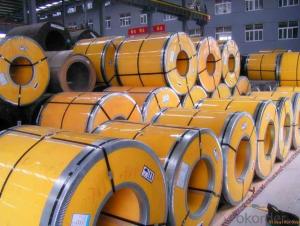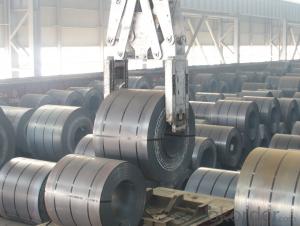Stainless Steel Coil Hot Rolled 304
- Loading Port:
- China Main Port
- Payment Terms:
- TT OR LC
- Min Order Qty:
- -
- Supply Capability:
- 5000 m.t./month
OKorder Service Pledge
OKorder Financial Service
You Might Also Like
Grade: | 300 Series | Standard: | JIS,AISI,ASTM,GB,DIN,EN etc | Thickness: | 2.5mm, 3.0mm, 4.0mm |
Width: | 550mm-1500mm | Length: | according to weight | Place of Origin: | China (Mainland) |
Brand Name: | CNBM | Model Number: | 304 | Technique: | Hot Rolled |
Application: | industry, construction, furniture, repairing | Certification: | MTC | Finishing: | NO.1 |
Market: | globle area | Packaged: | wooden and bags in cases as standard | Payment: | TT & LC |
Delivery time: | 15 days | MOQ: | 50 tons | Advantage: | prime quality, competitive price |
Profession: | hot rolled | Charactor: | stainless steel coils | Material/Grade: | 304 |
Hot Rolled Stainless Steel Coil 304
Specifications
1.surface:NO.1
2.standard:JIS, AISI, GB, DIN, EN etc
3.width: 0.55m, 0.65m, 1.0m, 1.22m, 1.5m, 2m or requirement
ASTM A240 304
(%):C=0.07, Mn=2.00, P=0.045, S=0.030, Si=0.075, Cr=17.5-19.5, Ni=8.0-10.5, N=0.10
Physical Properties
Tensile strength σb (MPa) ≥ 520
the conditions yield strength σ0.2 (MPa) ≥ 205,
elongation δ5 (%) ≥ 40
Reduction of ψ (%) ≥ 50,
hardness: ≤ 187
HB; ≤ 90
HRB; ≤ 200H
- Q:Can stainless steel strips be etched or engraved?
- Yes, stainless steel strips can be etched or engraved using various techniques such as chemical etching, laser engraving, or mechanical engraving.
- Q:What are the different finishes available for stainless steel strips?
- There are several different finishes available for stainless steel strips, each offering unique characteristics and aesthetic appeal. 1. No. 1 Finish: This is a hot-rolled annealed and descaled finish, which provides a dull, rough, and matte surface. It is commonly used in industrial applications where appearance is not a significant concern. 2. No. 2D Finish: This finish is also known as a "dull" finish and is achieved by cold-rolling the stainless steel strip after the annealing process. It has a smoother and more reflective appearance compared to the No. 1 finish. 3. No. 2B Finish: This is a bright, cold-rolled finish that is commonly used in commercial and residential applications. It has a smooth and reflective surface, making it suitable for decorative purposes. 4. No. 3 Finish: Also known as a "semi-polished" finish, it is achieved by using a 120-150 grit abrasive. This finish provides a smoother and more uniform appearance compared to the previous finishes. 5. No. 4 Finish: This is one of the most popular finishes for stainless steel strips. It is achieved by using a 150-180 grit abrasive, resulting in a brushed or satin-like appearance. It is often used in architectural and decorative applications. 6. No. 6 Finish: This finish is achieved by using a 240 grit abrasive, resulting in a finer brushed appearance compared to the No. 4 finish. It is commonly used in high-end architectural and decorative applications. 7. No. 7 Finish: This is a highly reflective mirror-like finish achieved by using a 320 grit abrasive. It provides a polished and sleek appearance and is often used in decorative applications. 8. No. 8 Finish: This is the highest grade mirror-like finish available for stainless steel strips. It is achieved by using a 400-600 grit abrasive, resulting in a flawless and reflective surface. It is commonly used in high-end architectural, automotive, and decorative applications. These different finishes allow for versatility in design and functionality, catering to various industries and aesthetic preferences.
- Q:Are stainless steel strips resistant to chemicals?
- Yes, stainless steel strips are generally resistant to chemicals. They have a high level of corrosion resistance, making them suitable for various chemical environments. However, the degree of resistance may vary depending on the specific type and grade of stainless steel used.
- Q:What are the advantages of using narrow width 111 stainless steel strips?
- There are several advantages to using narrow width 111 stainless steel strips. Firstly, the narrow width allows for more precise and accurate cutting, making it ideal for applications that require tight tolerances. This can be especially beneficial in industries such as automotive, aerospace, and electronics, where precision is crucial. Secondly, narrow width stainless steel strips are often more cost-effective compared to wider strips. This is because narrow strips require less material, reducing production costs and waste. Additionally, the narrower width allows for more efficient use of space during storage and transportation. Thirdly, narrow width strips offer greater flexibility in terms of design and application. They can be easily shaped and formed into various products, including components for machinery, appliances, and architectural features. This versatility makes them highly sought after in industries that require customized solutions. Furthermore, narrow width 111 stainless steel strips possess excellent corrosion resistance properties. Stainless steel is known for its ability to withstand harsh environments, including exposure to moisture, chemicals, and extreme temperatures. This makes it suitable for applications where durability and longevity are essential, such as in marine and chemical processing industries. Lastly, narrow width strips provide improved surface finish and aesthetic appeal. They can be polished, brushed, or coated to enhance their appearance, making them an attractive choice for decorative purposes or high-end products. In summary, the advantages of using narrow width 111 stainless steel strips include precise cutting capabilities, cost-effectiveness, flexibility in design, corrosion resistance, and improved surface finish. These benefits make them a preferred choice for a wide range of industries and applications.
- Q:How do you clean and maintain stainless steel strips?
- To clean and maintain stainless steel strips, there are a few simple steps you can follow. 1. Start by removing any loose dirt or debris from the surface of the strips. You can do this by wiping them with a soft cloth or using a brush with soft bristles. 2. Next, prepare a cleaning solution. You can use mild dish soap or a stainless steel cleaner specifically designed for this purpose. Dilute the cleaner in warm water according to the instructions on the product. 3. Dip a soft cloth or sponge into the cleaning solution and gently scrub the stainless steel strips, following the grain of the metal. Avoid using abrasive materials or scrub brushes as they can scratch the surface. 4. Rinse the strips thoroughly with clean water to remove any residue from the cleaning solution. 5. Once rinsed, dry the stainless steel strips completely using a soft cloth or towel. This step is crucial to prevent water spots or stains from forming on the surface. 6. For routine maintenance, you can use a stainless steel polish or a microfiber cloth to restore the shine and remove any fingerprints or smudges. Remember to always test any cleaning product on a small, inconspicuous area of the strip before using it on the entire surface to ensure compatibility and avoid any potential damage. With regular cleaning and proper maintenance, your stainless steel strips will retain their luster and durability for a long time.
- Q:Are stainless steel strips resistant to hydrochloric acid?
- Yes, stainless steel strips are generally resistant to hydrochloric acid. This is because stainless steel is known for its corrosion resistance and ability to withstand chemical attack. However, the level of resistance can vary depending on the grade of stainless steel used. Higher grades of stainless steel, such as 316 or 317, have a higher resistance to hydrochloric acid compared to lower grades like 304 or 430. It is important to note that prolonged exposure or contact with concentrated hydrochloric acid can still cause some corrosion or pitting in stainless steel, but it is generally considered to be one of the most resistant metals to this acid.
- Q:Can stainless steel strips be used in the automotive parts industry?
- Yes, stainless steel strips can be used in the automotive parts industry. Stainless steel is highly durable, corrosion-resistant, and has excellent strength-to-weight ratio, making it suitable for various automotive applications such as exhaust systems, trim, brackets, and reinforcements. Moreover, stainless steel's aesthetic appeal and low maintenance requirements further contribute to its popularity in the automotive industry.
- Q:Can stainless steel strips be painted or coated?
- Indeed, it is possible to paint or coat stainless steel strips. However, it is crucial to adequately prepare the surface prior to applying any paint or coating to guarantee adhesion and longevity. This typically involves thoroughly cleaning the stainless steel and employing a primer or etching solution to enhance bonding. Once the surface is prepared, one can apply various types of paints or coatings, such as epoxy, acrylic, or enamel. To achieve optimal outcomes, it is essential to choose a paint or coating specifically designed for use on stainless steel. Moreover, one should adhere to the manufacturer's instructions regarding proper drying and curing times to attain the desired finish and durability.
- Q:How is corrosion resistance achieved in stainless steel strips?
- The ability of stainless steel strips to resist corrosion is achieved through a combination of factors inherent to their composition and structure. The main factor responsible for corrosion resistance is chromium. By adding significant amounts of chromium to the steel alloy (typically at least 10.5%), a thin oxide layer is formed on the surface of the steel. This layer acts as a barrier, preventing further corrosion and protecting the underlying steel from corrosive elements. In addition to chromium, stainless steel also contains other alloying elements like nickel, molybdenum, and nitrogen, which further enhance its corrosion resistance. These elements help stabilize the oxide layer and improve resistance to specific types of corrosion. The microstructure of stainless steel also plays a crucial role in its corrosion resistance. It can exist in different crystal structures, such as austenitic, ferritic, martensitic, and duplex. The most common type used in stainless steel strips is austenitic stainless steel, which has a face-centered cubic structure. This structure provides excellent corrosion resistance and makes stainless steel strips suitable for various applications. Moreover, stainless steel strips can undergo different surface treatments to enhance their corrosion resistance. These treatments include passivation, pickling, and electropolishing, which remove impurities, contaminants, and free iron from the surface, promoting the formation of a more robust and protective oxide layer. Overall, the combination of alloying elements, oxide layer formation, microstructure, and surface treatments contribute to the remarkable corrosion resistance of stainless steel strips. This makes them highly durable and suitable for various environments and applications where corrosion is a concern.
- Q:How do stainless steel strips perform in high-temperature steam?
- Stainless steel strips perform exceptionally well in high-temperature steam due to their excellent resistance to corrosion and oxidation. They exhibit high strength, durability, and stability even under extreme heat and pressure conditions, making them suitable for various applications in steam-based industries such as power generation, chemical processing, and food production.
1. Manufacturer Overview |
|
|---|---|
| Location | |
| Year Established | |
| Annual Output Value | |
| Main Markets | |
| Company Certifications | |
2. Manufacturer Certificates |
|
|---|---|
| a) Certification Name | |
| Range | |
| Reference | |
| Validity Period | |
3. Manufacturer Capability |
|
|---|---|
| a)Trade Capacity | |
| Nearest Port | |
| Export Percentage | |
| No.of Employees in Trade Department | |
| Language Spoken: | |
| b)Factory Information | |
| Factory Size: | |
| No. of Production Lines | |
| Contract Manufacturing | |
| Product Price Range | |
Send your message to us
Stainless Steel Coil Hot Rolled 304
- Loading Port:
- China Main Port
- Payment Terms:
- TT OR LC
- Min Order Qty:
- -
- Supply Capability:
- 5000 m.t./month
OKorder Service Pledge
OKorder Financial Service
Similar products
New products
Hot products
Hot Searches
Related keywords






























